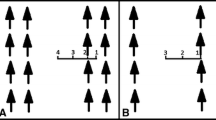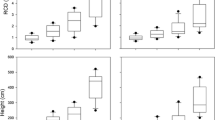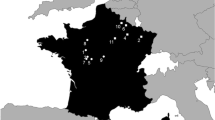Abstract
Two bamboo species,Neohouzeua dulloa A Camus andDendrocalamus hamiltonii Nees and Arn. show plasticity in architecture, biomass and nutrient allocation patterns over a successional gradient of up to 60 yr for the former and 25 yr for the latter. However, optimal biomass accumulation rate was attained in a 15 yr old fallow for both species. Maximum elongation and thickness of the zero-order branch (main axis) is attained in a 15 yr old fallow forNeohouzeua dulloa and in a 25 yr old fallow forDendrocalamus hamiltonii. The lower order branches produced on the zero-order branch ofNeohouzeua dulloa are generally sylleptic whereas those ofDendrocalamus hamiltonii are proleptic. Maximum elongation and thickness for the zero-order branch, and least bud dormancy on them occurred in a 15 yr old fallow forNeohouzeua dulloa and in a 25 yr old fallow forDendrocalamus hamiltonii. Dendrocalamus hamiltonii in a 5 yr old fallow had a well developed first-order branch system with diffusely placed lower order branch clusters appearing as if borne on the first-order branch, unlike in older fallows where first-order branch production was continuous and lower order branch clusters appeared as if borne on the zero-order branch itself. In older fallows both species tend to allocate more biomass and nutrients to the below-ground rhizomatous component, as an adaptation for survival and vegetative regeneration after slash and burn disturbance. The growth and architecture of both species are generally geared to capitalize upon the high light regime of the early successional environment, but with a limited ability byNeohouzeua dulloa to tolerate shade.
Similar content being viewed by others
References
Abrahamson W G and Caswell H 1982 On the comparative allocation of biomass, energy and nutrients in plants;Ecology 63 982–991
Allen S E, Grimshaw H M, Parkinson J A and Quarmby C 1974Chemical analysis of ecological materials (Oxford: Blackwell)
Boojh R and Ramakrishnan P S 1982a Growth strategy of trees related to successional status. I. Architecture and extension growth;For. Ecol. Manage. 4 359–374
Boojh R and Ramakrishnan P S 1982b Growth strategy of trees related to successional status. II. Leaf dynamics;For. Ecol. Manage. 4 375–386
Borchert R and Slade N A 1981 Bifurcation ratios and the adaptive geometry of trees;Bot. Gaz. 142 394–401
Brunig E F 1976 Tree forms in relation to environmental conditions: an ecological view point. inTree physiology and yield improvement (eds) M G R Cannell and F T Last (New York: Academic Press) pp 139–156
Chapin F S III 1980 The mineral nutrition of wild plants;Annu. Rev. Ecol. Syst. 11 233–260
Field C 1983 Allocating leaf nitrogen for the maximization of carbon gain: leaf age as a control on the allocation program;Oecologia 56 341–347
Gadgil M and Prasad S N 1984 Ecological determinants of life history evolution of two bamboo species of India;Biotropica 16 161–172
Hallé F, Oldeman R A A and Tomlinson P B 1978Tropical trees and forests: an architectural analysis (New York: Springer Verlag)
Hocking P J 1984 Accumulation, partitioning and redistribution of dry matter and mineral nutrients inIxia flexuosa L., with special reference to its coramaceous habit;Ann. Bot. 53 489–501
Janzen D H 1976 Why bamboos wait so long to flower;Annu. Rev. Ecol. Syst. 7 347–391
Keeley J E and Keeley S E 1977 Energy allocation patterns of a sprouting and non-sprouting species ofArctostophylos in the California Chaparrel;Am. Mid. Nat. 98 1–10
Kramer P J and Kozlowski T T 1979Physiology of woody plants (New York: Academic Press)
Mc Clure F A 1966The bamboos: A fresh perspective (Massachusetts: Harward University Press)
Murata Y 1969 Physiological responses to nitrogen in plants; inPhysiological aspects of crop yield (eds) J D Eastin, C Y Sullivan and C H M Van Bavel (Madison: Wisconsin Agronomy Society of America) pp 235–259
Nàtr L 1975 Influence of mineral nutrition on photosynthesis and the use of assimilates; inPhotosynthesis and productivity in different environments (ed.) J B Cooper (Cambridge: Cambridge University Press) pp 537–556
Nelson N D, Burk J and Icebrands J G 1981 Crown architecture of short-rotation, intensively cultured populus. I. Effects of close spacing on first order branch characteristics;Can. J. For. Res. 11 73–81
Ramakrishnan P S and Shukla R P 1982 On the relation among growth strategies, allocation pattern, productivity and successional status of trees of a sub-tropical forest community; inImprovement of forest biomass (ed.) P K Khosla (Solan: Indian Society of Tree Scientists) pp 403–412
Ramakrishnan P S and Toky O P 1981 Soil nutrient status of hill agro-ecosystems and recovery pattern after slash and burn agriculture (jhum) in north-eastern India;Plant Soil 60 41–64
Ramakrishnan P S, Toky O P, Mishra B K and Saxena K G 1981 Slash and burn agriculture in north-eastern India; inFire regimes and ecosystem properties (eds) H A Mooney, J M Bonnecksen, N L Christensen, J E Lotan and W A Reiners USDA, Forest Service, General Technical Report, WO26 pp 570–584
Rao K S and Ramakrishnan P S 1987 Comparative analysis of the population dynamics of two bamboo species,Dendrocalamus hamiltonii Nees and Arn. andNeohouzeua dulloa A. Camus in successional environment;For. Ecol. Manage. 21 177–189
Saxena K G and Ramakrishnan P S 1983 Growth and allocation strategies of some perennial weeds of slash and burn agriculture (jhum) in north-eastern India;Can. J. Bot. 61 1300–1306
Shukla R P and Ramakrishnan P S 1984 Leaf dynamics of tropical trees related to successional status;New Phytol. 97 697–706
Shukla R P and Ramakrishnan P S 1986 Architecture and growth strategies of tropical trees in relation to successional status;J. Ecol. 74 33–46
Singh J and Ramakrishnan P S 1982 Structure and function of a sub-tropical humid forest of Meghalaya. I. Vegetation biomass and its nutrients;Proc. Indian Acad. Sci. (Plant Sci.) 91 241–253
Takemouchi Y 1931 Systematisch-Vergleichende Morphologie und Anatomie der Vegetationsorgane der Japanischen Bambus-Arten;Tahoki Imp. Univ. (Formosa) Facul. Sci. Memo 3 60
Terry N and Ulrich A 1973 Effects of phosphorus defeciency on the photosynthesis and respiration of leaves of sugarbeat;Plant Physiol. 51 43–47
Toky O P and Ramakrishnan P S 1983a Secondary succession following slash and burn agriculture in north-eastern India. I. Biomass, Litterfall and Productivity;J. Ecol. 71 735–745
Toky O P and Ramakrishnan P S 1983b Secondary succession following slash and burn agriculture in north-eastern India. II. Nutrient cycling;J. Ecol. 71 747–757
Ueda K 1960 Studies on the physiology of Bamboo, with special reference to practical application;Bull. Kyoto Univ. For. No 30
Van Andel J and Vera F 1977 Reproductive allocation inSenecio sylvaticus andChamaenerion angustifolium in relation to mineral nutrition;J. Ecol. 65 747–758
Varmah J C and Bahadur K N 1980 Country report and status of research on bamboos in India;Indian For. Rec. (Botany),6 28
Williams R B and Bell K M 1981 Nitrogen allocation in Majave desert annuals;Oecologia 48 145–150
Author information
Authors and Affiliations
Rights and permissions
About this article
Cite this article
Rao, K.S., Ramakrishnan, P.S. Architectural plasticity of two bamboo species (Nehouzeua dulloa A Camus andDendrocalamus hamiltonii Nees and Arn.) in successional environments in north-east India. Proc. Indian Acad. Sci. 98, 121–133 (1988). https://doi.org/10.1007/BF03053397
Received:
Issue Date:
DOI: https://doi.org/10.1007/BF03053397




